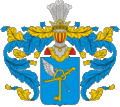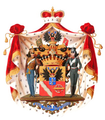Vasilchikov (noble family)
Wassiltschikow ( Russian : Васильчиковы) is the family name of an old Russian noble family . The Russian ancestor and progenitor of this family is Indris and goes back to the year 1353. The later princely family developed into a large and influential dynasty in Russia , with prominent personalities in politics , the military and science .
history
Indris, presumably from the area of the Grand Duchy of Lithuania , was first mentioned in a document in 1353, together with his sons Konstantin and Fyodor, and an armed force of 3000 men, he had settled in the former Principality of Chernigov . He is also considered the progenitor of the Tolstoy , Durnowo , Fedzow , Danilow , Tukhachevsky and Molchanov families . A family tree following from 1686, which the Tukhachevskis had kept, Indris is also called "Count Mons". The Wassilschikows belonged to the Greek Catholic Church and remained faithful to this creed.
The grandson of Constantine, Andrei Kharitonovich called “Tolstoy” moved to Moscow in the 15th century and lived with Grand Duke Vasily Vasilyevich the Blind (1425–1462), who nicknamed him Tolstoy ( Russian : “thick”, roughly “thicker “) Should have titled. Andrei also gave birth to the Muscovite line, which called itself "Vasilchikov". From her sex , later Wassiltschikows, many high offices on took over the courtyard of the Tsar.
In the 12th generation , between 1723 and 1737, the sex was divided into three lines. The first line was led by Semyon Grigoryevich, followed by Alexander Semjonowitsch Wassiltschikow (1746-1813), Vasili Semjonowitsch (1743-1808) and Ivan Semjonowitsch. The second line came from Nikolai Grigoryevich, but it was relatively inconspicuous. The youngest and third line was led by Alexei Grigoryevich († 1762), several well-known Russian generals and the later royal family came from it.
Nobility
After Alexei Grigorjewitsch, his son Vasily Alexejewitsch (1754-1830) and then Illarion Wassiljewitsch Wassiltschikow descended from the 3rd line . Illarion was raised to the rank of Russian count by Tsar Nicholas I of Russia (1796–1855) by the ukase of January 7, 1831 , with another ukase of January 1, 1839, he and his descendants were raised to the rank of Russian prince . This was followed by entries in the government registers of the nobility of Saint Petersburg , Moscow , Tula , Kovno , Yaroslavl , Novgorod , Pskov , Chernigov , Ryazan , Oryol , Saratov , Smolensk and Vladimir . Prince Illarion Vasilchikov was entered into the registers of the Estonian Knighthood , the Livonian Knighthood and the Courland Knighthood between 1839 and 1840. Although none of the dynasty members was resident in the Baltic Sea Governments , they belonged to the Baltic Knighthoods .
Known women
Anna Grigorievna Vasilchikov ( Russian : Анна Григорьевна Васильчикова), which in 1576 as a nun died Darya, was since 1575 for almost a year, the fifth wife of Tsar Ivan IV. Marie Vasilchikov gained with her book "The Berlin Diaries of Miss Marie" Missie " Wassiltschikow 1940–1945 “great reputation. “Princess Marie Wassiltschikow, born in St. Petersburg, spent her childhood and youth in Germany, France and Lithuania. In her diaries from 1940 to 1945 she describes life in the Reich capital Berlin ”.
Personalities
Generals in the Imperial Russian Army
- Illarion Wassiljewitsch Wassiltschikow (1776-1847); 1823 General of the Cavalry
- Illarion Illarionowitsch Wassiltschikow (1805-1862); 1846 major general, 1858 lieutenant general
- Sergei Illarionowitsch Wassiltschikow (1822-1859); Wing adjutant and major general
- Sergei Illarionowitsch Wassiltschikow (1849-1926); General of the cavalry
- Viktor Illarionowitsch Wassiltschikow (1820–1878); Lieutenant General, Adjutant General His Majesty
Possessions
In Wybiti there are the ruins of the manor house with a park as well as several other buildings that were formerly owned by the noble Vasilchikov family. The manor complex has been a listed building since 1975. In the urban area of Chekhov is the Satschatjewskoje estate (Зачатьевское), which once belonged to the Vasilchikovs.
coat of arms
The family coat of arms is registered in the XI. Part of the General Book of Arms of the Old Russian Empire. In addition to the family coat of arms, there is also the count's coat of arms; the royal families that have grown up from the original line, such as Tolstoy, have similar coats of arms.
Family coat of arms
The coat of arms of the Wassiltschikows shows an azure blue shield with a horizontally placed golden saber . A silver arrow pointing up to the left corner is threaded into the ring of a gold key . A silver flight stretched out from the key ring extends to the right corner of the shield .
Princely coat of arms
The main coat of arms is located in the middle of the large princely coat of arms. It is horizontally divided into two halves, in the upper golden part is the double-headed, three-crowned Imperial Russian black eagle . In his right foot that holds the scepter and in the left foot orb . In the middle of the eagle's chest is the coat of arms of Moscow . The lower half is divided vertically into two parts, both of which have a red field. In the first part, from the upper right to the lower left corner, a silver river is placed, and in the second part - on a broken silver wheel , a golden cannon barrel with a mouth to the left is depicted. The coat of arms is crowned with a noble helmet with the count's crown to indicate the elevation of the noble branch of the family name in the first place in the count's dignity. Above the count's crown an emerging black imperial eagle with crowns, a scepter and an imperial orb. The Moscow coat of arms is located on the chest. On the right side of the eagle is the standard of the Akhtyr Hussar Regiment, and on the left side is a red badge with a silver lily from 1814 to commemorate the regiment in Versailles with General Illarion Wassiljewitsch Wassilschikow. The shield holders are on the right the hussar of the octyrian regiment, on the left the grenadier in the uniform of the regiment he formed in France. A banner with the motto : "LIFE TO THE CzAR, THE KING, HONOR NO ONE" is placed below the shield. The coat of arms is covered with a prince's coat and a prince's hat.
Family table
Grigori Wassiltschikow (around 1555)
- Lukian ( Lucian ) Wassiltschikow (1592–1650)
- Simjon Lukianowitsch Wassiltschikow (* 1640)
- Grigori Semjonowitsch Wassiltschikow (* 1663), then the division into three lines followed
1st line
- Semjon Grigoryevich Wassiltschikow ( 1st line , around 1671–1725)
- Ivan Semjonowitsch Wassiltschikow (around 1708–1765)
- Alexander Ivanovich Wassiltschikow (1739–1799)
- Nikolai Alexandrowitsch Wassiltschikow (1799–1864), Dekrabist
- Alexander Ivanovich Wassiltschikow (1739–1799)
- Alexander Semjonowitsch Wassiltschikow (1746–1813) (1746–1813) was one of the favorites and lovers of the Russian Tsarina Katharina the Elder. Great (1729-1796).
- Wassili Semjonowitsch Wassiltschikow (1743–1808), Chamberlain
-
Alexei Wassiljewitsch Wassiltschikow (1776–1854), Russian senator
- Alexander Alexejewitsch Wassiltschikow (1832–1890), director of the Hermitage in St. Petersburg
-
Alexei Wassiljewitsch Wassiltschikow (1776–1854), Russian senator
- Ivan Semjonowitsch Wassiltschikow (around 1708–1765)
2nd line
- Nikolai Semjonowitsch Wassiltschikow ( 2nd line , around 1668–1727)
- Ivan Nikolajewitsch Wassiltschikow (around 1727–1787)
- Nikolai Ivanovich Wassiltschikow (1792–1855), Russian major general
- Ivan Nikolajewitsch Wassiltschikow (around 1727–1787)
3rd line
- Alexei Grigoryevich Wassiltschikow ( 3rd line )
-
Wassili Alexejewitsch Wassiltschikow (1754-1830), Russian brigadier general
- Illarion ( Hilarion ) Wassiljewitsch Wassiltschikow, Count and Prince ( Princely Line )
- Dimitri Wassiljewitsch Wassiltschikow (1778-1859), Russian cavalry general, State Councilor
- Nikolai Wassiljewitsch Wassiltschikow (1781–1849), Russian major general, state councilor and governor
-
Wassili Alexejewitsch Wassiltschikow (1754-1830), Russian brigadier general
Princely family tree
Illarion Wassiljewitsch Wassiltschikow , Count since July 6, 1831, Prince (1776–1847) since January 1, 1839, Adjutant General to His Majesty , General of the Cavalry, Inspector General of the Cavalry ⚭ 1st marriage: Vera Countess Protasov (1780–1814); 2nd marriage: Tatiana Paschkow (1793–1875 in Saint Petersburg ), daughter of Vasily Alexandrowitsch Tolstoy (1759–1834)
- Prince Illarion Illarionowitsch Wassiltschikow (1805-1862), adjutant general to his majesty , governor-general in Kiev ⚭ Katharina Princess Shcherbatow (1828-1869)
- Prince Sergei Illarionowitsch Wassiltschikow , (* 1849 in Kiev, † 1926 in Versailles ). Adjutant General, General of the Cavalry ⚭ Marie Issakow (* 1853 in Saint Petersburg, † 1922 in Baden-Baden )
- Prince Illarion Sergejewitsch Wassiltschikow (* 1881 in Saint Petersburg), chamberlain , aristocratic marshal , member of the Reich Duma ⚭ Lidia Leonidowna Princess Vyazemsky (* 1886)
- Prince Alexander Illarionowitsch Wassiltschikow (* 1912 in Saint Petersburg, † 1939 in Lausanne )
- Prince Georg Illarionowitsch Wassiltschikow (* 1919 in Beaulieu-sur-Mer )
- Prince Nikolai Sergejewitsch Wassiltschikow (* 1883 in Saint Petersburg, † 1927 in Versailles), chamberlain and titular councilor
- Prince Illarion Sergejewitsch Wassiltschikow (* 1881 in Saint Petersburg), chamberlain , aristocratic marshal , member of the Reich Duma ⚭ Lidia Leonidowna Princess Vyazemsky (* 1886)
- Prince Sergei Illarionowitsch Wassiltschikow , (* 1849 in Kiev, † 1926 in Versailles ). Adjutant General, General of the Cavalry ⚭ Marie Issakow (* 1853 in Saint Petersburg, † 1922 in Baden-Baden )
- Prince Alexander Illarionowitsch Wassiltschikow (1818–1881), chamberlain, master of ceremonies , aristocratic marshal in Nowgerod and governor in Nowgerod ⚭ Eugenie Senjawin (* 1829; † 1862 in Dresden )
- Prince Boris Alexandrowitsch Wassiltschikow (* 1860, † 1931 in Menton ), court stable master , imperial councilor , aristocratic marshal, governor in Pskow, honorary citizen of the city of Staraya Russa ⚭ Sophie Princess Meschtscherski (* 1867; † 1942 in Paris)
- Prince Viktor Illarionowitsch Wassiltschikow (1820–1878), adjutant general to his majesty, lieutenant general and chief of staff
- Prince Sergei Illarionowitsch Wassiltschikow (1822-1859), Colonel
- Prince Wassili Illarionowitsch Wassiltschikow (1826–1867), Lieutenant Colonel
Web links
Individual evidence
- ↑ Frank Kämper , Ivan (IV.) The Terrible 1533–1584. In: The Russian Tsars 1574–1917, Ed. Hans-Joachim Torke, Verlag CH Beck, 1999, p. 27
- ^ Marie Wassiltschikow: The Berlin diaries of Marie "Missi" Wasiltschikow 1940-1945 , translated from the English by Elke Jessett. Siedler Verlag, Berlin 1987, ISBN 3-88680-238-8 .
- ↑ Der Kampf um Berlin, books on the subject, Spiegel online, [1] , accessed on October 31, 2019
- ↑ List of Russian Generals and Admirals [2] (Russian)
- ^ Ancestral coat of arms of the Wassilschikows [3] (Russian)
- ↑ Heraldry: ВАСИЛЬЧИКОВЫ [4] (Russian)
- ^ Prince Wassiltschikow, Livonia, Estonia, Courland, (Russian old nobility) Russ. Prince 1839. In: Adelsvapen-Wiki [5]
- ↑ Depiction of the coat of arms [6] (Russian)
- ↑ motto. In: Genealogisches Handbuch der Baltic Ritterschaften, Görlitz o. J., Blazonierung des Fürstlichen Wappen, S. 869/870 [7] , accessed October 31, 2019
- ↑ Carolly Erickson, Katharina the Great, A German Princess on the Tsar's Throne, German by Anna Spielmann, Rowohlt Taschenbuch Verlag , Reinbek bei Hamburg, 1997, p. 329 ff.







